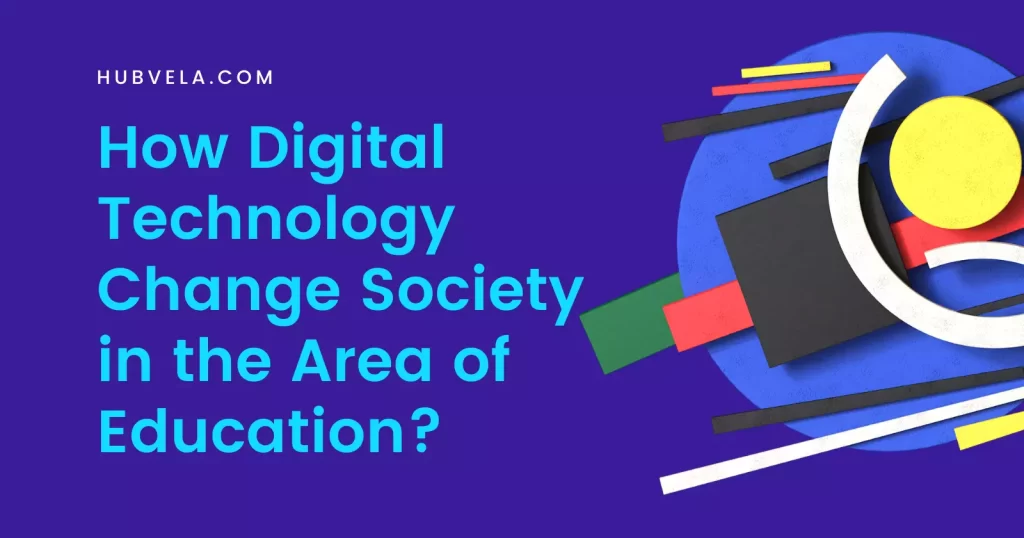Digital technology has revolutionized various aspects of our lives, including education. With the widespread use of technology, education has become more accessible, interactive, and engaging.
Technology has transformed the traditional classroom setting into a more dynamic and flexible learning environment.
The introduction of new technology-assisted learning tools such as mobile devices, multimedia, and online platforms has made education more adaptive and easier to understand.
In this article, we will explore how digital technology is changing society in the area of education. We will discuss the impact of technology on teaching and learning, the benefits of technology in education, and the challenges that come with it.

--Advertisement--
How Digital Technology Change Society in the Area of Education (Infographics)

Digital Learning Platforms (Access and Flexibility in Education)
Digital learning platforms are online tools that provide access to educational resources and courses. These platforms have revolutionized the way people learn and have made education more accessible and flexible.
Here are some ways in which digital technology has changed society in the area of education:
Increased Access to Education: Digital learning platforms have made education more accessible to people all over the world. With these platforms, anyone with an internet connection can access educational resources and courses from top universities and institutions.
Flexibility: Digital learning platforms offer flexibility in terms of when and where people can learn. Learners can access courses and resources at their own pace and from anywhere they have an internet connection. This flexibility is particularly beneficial for people who have busy schedules or live in remote areas.
Personalization: Digital learning platforms allow for personalized learning experiences. Learners can choose courses and resources that are relevant to their interests and goals, and they can learn at their own pace. This personalized approach to learning can lead to better outcomes and more engaged learners.
Cost-Effective: Digital learning platforms are often more cost-effective than traditional education. Learners can access courses and resources for free or at a lower cost than traditional education. This makes education more accessible to people who may not have the financial means to attend traditional institutions.
Innovative Teaching Methods: Digital learning platforms often use innovative teaching methods, such as gamification and interactive content, to engage learners. These methods can make learning more fun and engaging, leading to better outcomes.
Some of the best digital learning platforms include Coursera, Udemy, Skillshare, Edx, Pluralsight, Future Learn, and Moodle. These platforms offer a wide range of courses and resources, from short videos to online degrees.
They also offer features such as content authoring, course management, user management, reporting, and integrations. Digital learning platforms have changed society in the area of education by making education more accessible, flexible, and personalized.
Personalized Learning – Tailoring Education to Individual Needs
Personalized learning is an educational model in which instruction meets individual students’ needs and learning styles.
This approach tailors learning experiences to meet the specific needs of each student, using technology to assess their unique learning needs, preferences, and performance data.
Personalized learning can be achieved through the purposeful design of blended instruction, combining face-to-face teaching, technology-assisted instruction, and student-to-student collaboration.
The use of digital technology in schools with a school-wide approach to personalized learning has been examined in research.
The advantages of personalized learning include improved engagement, motivation, and better outcomes.
Personalized classroom experiences may also remedy some of the learning loss that occurred during the COVID-19 pandemic. Teachers can use tech solutions to pinpoint proficiency status and provide personalized academic support.
Technology has revolutionized personalized learning by providing teachers with tools to tailor instruction to individual students, flexibility in learning environments and resources, increased access to learning materials, and improved communication and collaboration between students and teachers.
However, there are also challenges to be addressed, such as technical issues and potential distractions. As technology continues to advance, the future implications for education are promising, with the potential to further improve personalized learning experiences for students.
Enhanced Engagement and Interactivity in the Classroom
Digital technology has revolutionized the way we live, work, and learn, and the classroom is no exception.
Incorporating digital technology into the classroom can lead to profound advances in student engagement and learning, ensuring that students are keeping up with the demands of a technology-based world.
Here are some ways in which digital technology can enhance engagement and interactivity in the classroom:
Gamified Learning: Gamified learning makes education fun and engaging as students earn badges and move through competencies.
Interactive Software and Programs: Many teachers use interactive software and programs as learning technologies so that students can respond to questions and lectures digitally.
Collaboration: Technology makes it easier for students to collaborate and save their work. Students can work together on digital collections of research and ideas, draw and write together in the same program, and create posters or notes of their work together.
Front-loading New Content: Technology can be used to front-load new content prior to teaching synchronous lessons. This can help students stay on task and interested, particularly if the content is interactive.
Flexible and Democratic Styles of Teaching and Learning: Technology can facilitate more flexible and democratic styles of teaching and learning, providing students with more autonomy and control over their learning, and encouraging the development of cognitive competencies and understanding.
Increased Social Interaction: Digital technology can promote more engaged students, leading to increased social interaction and digital capital.
Tech Tools that Encourage Creativity: Students engage deeply in class when tech tools encourage them to construct ideas, collaborate with peers, and create unique work.
Digital technology can increase student engagement in a productive way, providing opportunities for a sense of community, accessibility, support, motivation, interest in learning, and self-regulation.
Global Learning Connections
Digital technology has had a significant impact on society, particularly in the area of education. Here are some ways in which digital technology has changed education and broken down geographic boundaries:
Global Learning: Digital technology has enabled global learning connections, allowing students to access people, perspectives, expertise, and experiences on a global scale. Students can collaborate with peers from around the world, participate in virtual exchange programs, and engage in cross-cultural learning experiences.
Access to Information: The internet and digital media provide students with access to a vast array of information and resources from around the world. Students can explore different cultures, languages, and perspectives through online platforms, videos, and interactive content.
Collaboration and Communication: Digital technology facilitates collaboration and communication among students and educators across geographical boundaries. Students can work together on projects, share ideas, and engage in real-time discussions through online platforms, video conferencing, and social media.
Personalized Learning: Digital technology allows for personalized learning experiences tailored to individual students’ needs and interests. Adaptive learning platforms, online assessments, and data analytics help educators track student progress and provide targeted support.
Professional Development: Digital technology provides opportunities for educators to engage in professional development and connect with colleagues globally. Online courses, webinars, and virtual conferences enable educators to enhance their teaching practices and stay updated with the latest educational trends and research.
Equity and Inclusion: Digital technology has the potential to bridge the digital divide and provide equal access to education. Efforts are being made to ensure that all students have access to digital devices, internet connectivity, and quality online educational resources.
Lifelong Learning: Digital technology promotes lifelong learning by providing opportunities for continuous education and skill development. Online courses, e-learning platforms, and educational apps enable individuals to acquire new knowledge and skills at their own pace and convenience.
Digital technology has transformed education by breaking down geographic boundaries, enabling global learning connections, and providing access to information and resources from around the world.
It has revolutionized teaching and learning methods, and personalized education, and promoted equity and inclusion in education.
EdTech Tools for Special Needs Education and Inclusivity
Digital technology has brought significant changes to the field of education, particularly in the area of special needs education and inclusivity.
Educational technology, or EdTech, is transforming the learning experience for special needs students, making education more accessible, engaging, and inclusive.
Here are some ways in which EdTech tools are helping students with special needs:
Assistive technology: EdTech is being used as assistive technology to help accommodate students with special needs. Common devices with accessibility features and purpose-built software are making education more inclusive than ever.
Accommodations and modifications: EdTech tools can create accommodations and modifications for a wide range of students, helping them progress on their own level and be placed in general classroom settings.
Communication and social interaction: Many EdTech tools offer features like chat boards, video conferencing, and virtual reality simulations that facilitate collaboration and socialization. These platforms enable students to connect with their peers, teachers, and experts from around the world, breaking down physical barriers and fostering a sense of community and inclusiveness.
To meaningfully engage in digital learning, students need access to a device and the internet. Teachers need to have a current understanding of what technology tools are available, what their school can and does provide, and what families can access.
It is also important to build an understanding of digital citizenship by exploring resources like Common Sense Media’s Inside The 21st-Century Classroom report on EdTech usage by K-12 teachers with their students and observations on its impact on learning.
EdTech is playing a pivotal role in making education more inclusive for special needs students. It is creating new opportunities for students with diverse needs and breaking down physical barriers to learning.
Optimizing Education Outcomes with Data-Driven Decision
Data-driven decision-making is a process that involves collecting, analyzing, and using data to inform decisions in education.
Digital technology has revolutionized data-driven decision-making in education by providing tools that can reveal hidden patterns and insights, help teachers organize data, and keep it up to date.
Here are some ways digital technology has changed society in the area of education:
Improved Teacher Responsiveness: Data-driven decision-making can help teachers be more responsive to students’ needs by providing them with useful data about who might need extra help and which students might best lead class discussions.
Identifying Struggling Students: Data-based decision-making is a system of procedures that teachers use to identify why a student is struggling. By analyzing data, teachers can identify students who need extra support and customize their instruction accordingly.
Eliminating Bias: Data-driven decision-making can help eliminate bias by providing objective data that can be used to make decisions.
Transforming Teaching and Learning: Data-driven decision-making can transform teaching and learning by helping teachers identify students’ strengths and weaknesses regarding learning objectives and taking this knowledge into the design of future instruction.
Improving Student Achievement: Research shows that schools implementing data-driven decision-making are most successful when their staff works in professional learning communities. By using data to inform decisions, schools can improve student achievement and ensure instruction is relevant.
Digital technology has changed society in the area of education by providing tools that can help teachers make data-driven decisions, improve student achievement, and transform teaching and learning.
Challenges of Digital Education
Digital education has the potential to revolutionize the field of education, providing new opportunities for learning and engagement. However, it also presents challenges, particularly in terms of equity and accessibility.
Here are some of the challenges of digital education and how they relate to the changes brought about by digital technology in the area of education:
The Digital Divide: The digital divide refers to the gap between those who have access to digital technologies and those who do not. This divide can be based on factors such as socioeconomic status, geographic location, and race/ethnicity. The digital divide exacerbates existing inequalities in education, as students without access to technology may be unable to participate fully in digital learning.
Lack of Internet Access: Reliable, high-speed Internet access is essential for digital education. However, many students, particularly those from low-income backgrounds or rural areas, lack access to affordable and reliable internet connections. This lack of internet access limits their ability to engage in online learning and access digital resources.
Limited Access to Devices: Even if students have internet access, they may not have access to the necessary devices, such as computers or tablets, to fully participate in digital education. This lack of access to devices can further widen the digital divide and hinder students’ ability to engage in online learning.
Digital Literacy Skills: Digital literacy skills, including the ability to navigate digital platforms, critically evaluate online information, and use digital tools effectively, are crucial for success in digital education. However, not all students have equal opportunities to develop these skills, which can create barriers to their participation in digital learning.
Cultural and Neurodiversity Considerations: Digital education should be culturally responsive and consider the diverse learning needs of students, including those with neurodiverse conditions. It is important to ensure that digital learning platforms and resources are accessible and inclusive for all students, regardless of their cultural background or learning differences.
To address these challenges and promote equity and accessibility in digital education, various strategies can be implemented:
Closing the Digital Divide: Efforts should be made to bridge the digital divide by providing internet access and devices to students who lack them. This can be done through initiatives that focus on increasing broadband availability, providing subsidies for internet access, and distributing devices to students in need.
Culturally Responsive Education: Digital education should be designed with cultural responsiveness in mind, taking into account the diverse backgrounds and experiences of students. This includes incorporating culturally relevant content, providing multilingual resources, and ensuring that digital platforms are accessible to students from different cultural backgrounds.
Universal Design for Learning: Universal Design for Learning (UDL) is an approach that aims to make learning accessible to all students, regardless of their learning differences or disabilities. UDL principles can be applied to digital education by providing multiple means of representation, engagement, and expression. This ensures that students with diverse learning needs can access and engage with digital learning materials.
By addressing these challenges and implementing strategies to promote equity and accessibility, digital education can become a powerful tool for transforming education and providing equal opportunities for all students.
Privacy and Security in Digital Education
Data Privacy: With the integration of digital technology in education, there are ethical considerations regarding data privacy. Educational institutions collect and store vast amounts of data on students, including personal information, academic records, and learning analytics. It is crucial to ensure that this data is protected and used responsibly to maintain the privacy of students.
Security Risks: The use of digital technology in education also brings security risks. Educational institutions must invest significant resources in implementing robust security measures to prevent data breaches and cyber-attacks. The ethical consequences of exposing personal data can be severe, and it is the responsibility of organizations and authorities to monitor and enforce the secure handling of private data.
Ethical Guidelines: Ethical guidelines for educators and information professionals play a vital role in ensuring privacy and security in digital education. These guidelines help establish best practices for handling student data, including obtaining informed consent, securely storing data, and ensuring transparency in data usage.
Educational Data Ethics: The field of educational data ethics focuses on the ethical considerations related to the collection, analysis, and use of data in education. This includes issues such as learning analytics, data sharing, and the responsible use of artificial intelligence in educational settings. It is essential to address these ethical challenges to protect the privacy and rights of students and educators.
Digital Citizenship: Digital citizenship education plays a crucial role in promoting ethical behavior and responsible use of digital technology in education. Students should be educated about the risks associated with online activities, such as sharing personal information and engaging in digital commerce. They should also understand the importance of protecting their own and others’ security online.
Teacher Training: Educators need to be equipped with the knowledge and skills to navigate the ethical considerations of digital education. Teacher training programs should include education on data privacy, data ethics, and responsible use of technology. This will enable teachers to protect their students’ privacy and effectively communicate with families about data privacy issues.
The integration of digital technology in education brings about ethical considerations regarding privacy and security.
It is essential to establish ethical guidelines, provide training to educators, and promote digital citizenship to ensure responsible and ethical use of technology in education.
Teacher-Student Relationships in the Digital Classroom
In the digital classroom, teacher-student relationships are influenced by the use of digital technology. Here are some ways in which digital technology changes society in the area of education and impacts teacher-student relationships:
Increased access to information: Digital technology provides students with access to a vast amount of information and resources. This allows teachers to facilitate more independent and self-directed learning, as students can explore topics of interest and conduct research online.
Enhanced communication: Digital technology enables teachers and students to communicate and interact more easily. Online platforms, messaging apps, and video conferencing tools facilitate real-time communication, allowing for immediate feedback and support.
Personalized learning: Digital technology allows for personalized learning experiences tailored to individual students’ needs and preferences. Adaptive learning platforms and educational apps can provide customized content and activities, helping students learn at their own pace.
Collaborative learning: Digital technology promotes collaboration among students. Online discussion forums, virtual group projects, and shared documents enable students to work together, even if they are not physically present in the same location.
Increased engagement: Incorporating digital technology into the classroom can lead to increased student engagement. Interactive multimedia, gamified learning platforms, and virtual reality experiences can make learning more interactive and immersive, capturing students’ attention and motivation.
Teacher professional development: The use of digital technology in education requires teachers to develop new skills and competencies. Professional development programs and training opportunities help teachers become proficient in using technology effectively in the classroom.
Equity and inclusion: Digital technology has the potential to bridge the digital divide and provide equal educational opportunities for all students. However, it is important to ensure that access to technology and digital resources is equitable to avoid exacerbating existing inequalities.
It is worth noting that the impact of digital technology on teacher-student relationships can vary depending on factors such as teachers’ familiarity with technology, their attitudes toward its use, and the level of support and training provided.
The integration of digital technology in the classroom has the potential to transform education and enhance teacher-student relationships by promoting collaboration, personalized learning, and increased engagement.
Parental Involvement and Support in the Age of EdTech
In the age of EdTech, parental involvement and support in education have taken on new forms. Here are some ways digital technology has changed society in the area of education:
Improved communication: Digital technology has made it easier for parents and teachers to communicate with each other. Apps like ClassTag and SchoolBzz are designed to help schools engage parents in their community and improve the quality of family support in education. Digital outreach can help parents stay informed, become more involved, and be better positioned to help with kids’ schoolwork—all factors driving better student engagement and performance.
Increased access to information: Educational apps and online platforms have made it easier for parents to stay informed about their children’s progress in school. The Parent and Family Digital Learning Guide provides information for parents and caregivers to monitor their child’s progress as their child accesses and uses technology for learning. Advanced features of some educational apps translate report cards into languages from Arabic to Vietnamese.
Enhanced parental involvement: Parental involvement can lead to improved student outcomes. Digital technology has made it easier for parents to be involved in their children’s education. For example, the NBC News Learn Parent Toolkit shows examples of what important math, English, and social-emotional skills look like by age.
Show What You Know: A Parent’s Guide To The Global Shift to Competency explains additional benefits of competency-based learning.
Improved student engagement: Students are more engaged when parents and families are involved in education. Digital learning resources provide new opportunities for families to develop a strong partnership with schools or education providers.
Digital technology has changed society in the area of education by improving communication, increasing access to information, enhancing parental involvement, and improving student engagement.
Role of Digital Technology in Education
Digital technology plays a significant role in education, offering various benefits and opportunities for both students and teachers. Here are some key points regarding the role of digital technology in education:
Enhanced Learning Experience: Digital technology provides interactive and engaging learning experiences for students. It allows for multimedia content, simulations, and virtual reality experiences that can make complex concepts easier to understand.
Increased Access to Resources: Digital technology provides students with access to a vast range of educational resources. Online libraries, databases, and educational websites offer a wealth of information that can supplement classroom learning.
Improved Collaboration: Digital tools enable students to collaborate with their peers and teachers, even when they are not physically present in the same location. Online discussion forums, video conferencing, and collaborative platforms facilitate communication and teamwork.
Personalized Learning: Digital technology allows for personalized learning experiences tailored to individual student needs. Adaptive learning platforms and intelligent tutoring systems can provide targeted instruction and feedback based on each student’s strengths and weaknesses.
Efficient Assessment and Feedback: Digital technology simplifies the assessment process by automating grading and providing immediate feedback to students. Online quizzes, automated grading systems, and data analytics help teachers track student progress and identify areas for improvement.
Preparation for the Future: Digital technology equips students with the skills they need for the modern workforce. It helps develop digital literacy, critical thinking, problem-solving, and collaboration skills that are essential in today’s digital age.
Flexibility and Accessibility: Digital technology enables flexible learning environments, allowing students to access educational materials and resources anytime and anywhere. This is particularly beneficial for remote learning, distance education, and students with special needs.
Despite the numerous benefits, it is important to note that technology should be used as a tool in education and not as an end in itself.
The effective integration of digital technology requires proper training and support for teachers, as well as addressing concerns such as the digital divide and ensuring equitable access to technology.
Digital technology has the potential to transform education by enhancing learning experiences, expanding access to resources, and preparing students for the future.
It is crucial for educators to harness the power of digital technology to create engaging and effective learning environments.
Conclusion on How Digital Technology Change Society in the Area of Education
In conclusion, digital technology has brought significant changes to education. Integrating technology into education provides students with an engaging learning experience, allowing them to remain more interested in the subject without getting bored.
However, it is important to evaluate the use of primary or secondary sources for support and to avoid plagiarism. A critical literature review on the use of information and communication technology (ICT) in education shows that it has both positive and negative effects.
While online learning has been found to be effective, difficulties and confusion can arise in digital learning environments.
The negatives of digital life include an overall decrease in short-term memory, an increase in expectations for instantaneous responses, and difficulty in taking one’s eyes off a screen to enjoy life as it’s happening.
Therefore, while digital technology has brought many benefits to education, it is important to be aware of its potential negative impacts and to use it in a balanced and responsible manner.


